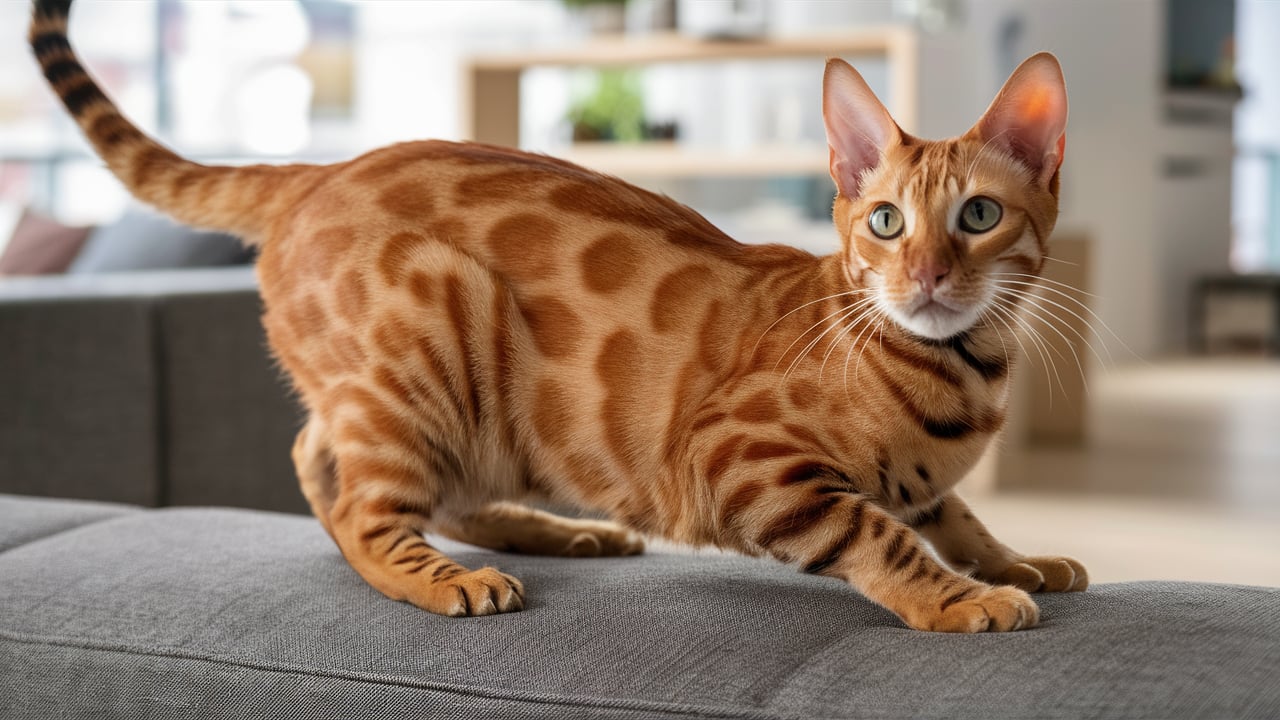Introduction
If you’ve ever seen a Bengal cat, you know they’re striking, but have you heard of the orange Bengal cat? This unique variation in the Bengal breed has been catching the eyes of cat lovers everywhere. Their distinctive orange coat adds an extra touch of warmth and wild elegance, making them stand out even among the already exotic-looking Bengals.
History of the Bengal Cat
Origins of the Bengal Cat Breed
The Bengal cat is a relatively modern breed, created by crossing domestic cats with the wild Asian leopard cat. This unique combination aimed to preserve the wild appearance of the leopard while ensuring the pet remained as friendly and trainable as a domestic cat. The result? An extremely beautiful and loving breed.
How the Bengal Breed Was Developed
The Bengal breed was officially recognized in the 1980s, after years of careful breeding to ensure that the wild traits were tamed and the domestic qualities were enhanced. This breed has since become one of the most popular and recognizable in the world.
What Makes an Orange Bengal Cat Unique?
The Distinct Coat Color of the Orange Bengal
The orange Bengal cat is not your average Bengal. While most Bengals are known for their striking brown or snow-colored coats with rosettes or marbling, the orange Bengal’s coat takes on a warmer, more vibrant hue. This orange tint is what sets them apart and makes them so highly sought after.
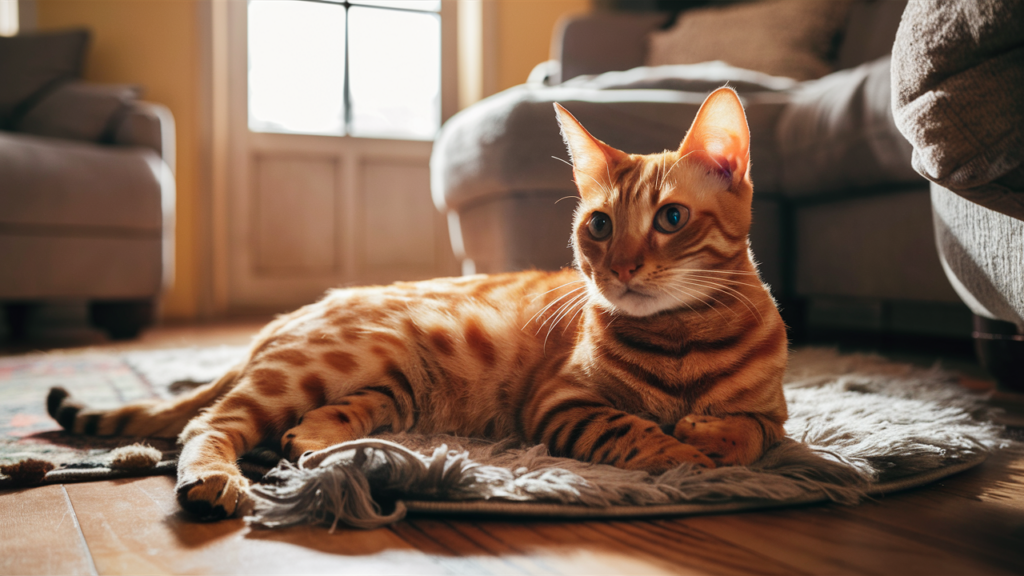
Genetic Factors Contributing to the Orange Coloration
The orange color in Bengal cats is a result of specific genetic factors. These factors can include a combination of the cat’s base color and the presence of certain genes that influence pigmentation.Although rare, this hue is a natural variant found in the Bengal breed.
Physical Characteristics
Coat Texture and Patterns
Orange Bengal cats maintain the same luxurious coat texture that Bengals are known for—short, soft, and sleek. Their coats may display classic Bengal patterns, such as rosettes or marbling, but with a unique orange or golden glow that enhances their exotic look.
Size and Body Structure
Bengal cats, including the orange variety, are medium to large-sized cats with a muscular build. They have strong, athletic bodies and a graceful, leopard-like gait that contributes to their wild appearance.
Personality Traits
Temperament and Behavior
Bengals are known for their lively and playful nature. The orange Bengal cat is no exception. They are intelligent, curious, and love to be involved in whatever their human is doing. These cats are highly interactive and enjoy mental and physical challenges.
Interaction with Humans and Other Pets
Orange Bengals are known to be affectionate with their owners. They often form strong bonds with their human families and can get along well with other pets, provided they are properly socialized from a young age.
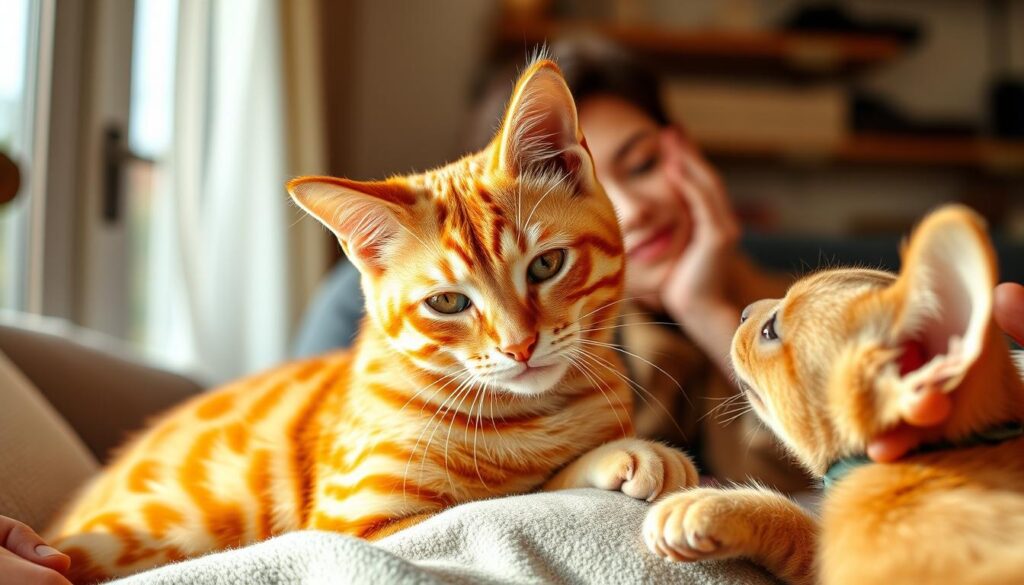
Care Requirements
Grooming Needs
Despite their exotic appearance, Bengal cats, including the orange variety, have relatively low grooming needs. Their short coat requires minimal brushing—just enough to keep it shiny and remove any loose fur.
Dietary Requirements
Like all cats, orange Bengals need a balanced diet rich in protein. High-quality commercial cat food, or a carefully planned raw diet, can provide the nutrients they need to thrive.
Exercise and Mental Stimulation
Due to their active lifestyle, Bengal cats need a lot of mental and physical stimulation. Providing them with interactive toys, puzzle feeders, and opportunities to climb and explore will keep them happy and healthy.
Health Considerations
Common Health Issues in Bengal Cats
Bengal cats are typically healthy, yet they can be vulnerable to specific genetic disorders just like any other breed. These can include heart disease, progressive retinal atrophy, and hip dysplasia.
Specific Concerns for Orange Bengal Cats
While the orange coloration itself doesn’t pose any specific health risks, it’s important to ensure that any Bengal, regardless of color, comes from a reputable breeder who tests for genetic conditions.
Training Your Orange Bengal Cat
Basic Training Tips
Training a Bengal cat can be both fun and rewarding. Begin with fundamental directives such as “sit” and “come,” then use constructive reinforcement methods like rewards and praise. Bengals are intelligent and can even be trained to walk on a leash.
How to Address Common Behavioral Issues
Bengals, including orange ones, can sometimes be a bit too energetic. If your cat starts displaying unwanted behaviors like excessive scratching or biting, make sure they have enough outlets for their energy. Redirecting their attention to toys or engaging them in play can help curb these behaviors.
Orange Bengal Cats as Pets
Suitable Home Environments
Orange Bengals thrive in environments where they have plenty of space to roam and explore. They are not typically suited to small apartments unless provided with ample opportunities for exercise.
Compatibility with Children and Other Pets
Orange Bengals can be great with children and other pets, as long as they are introduced properly. Their playful nature makes them a hit with kids, and they can coexist with other animals if they are socialized from a young age.
Socialization and Interaction
Importance of Early Socialization
Socialization is key for any Bengal cat, including the orange variety. Early exposure to different people, pets, and environments will help ensure that your Bengal grows up to be a well-adjusted and confident cat.
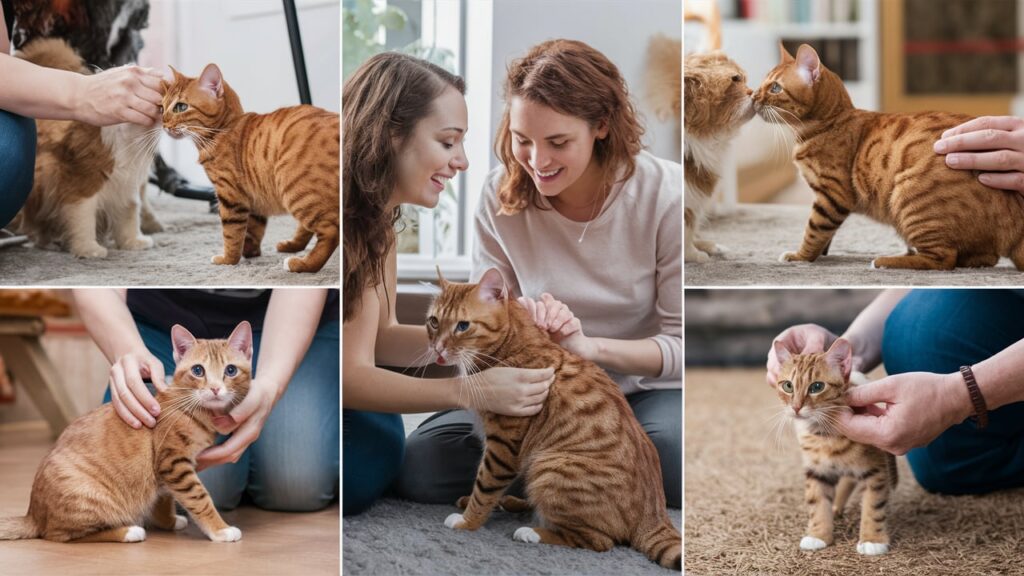
Tips for Ensuring a Well-Adjusted Bengal Cat
To ensure your orange Bengal cat is well-adjusted, provide plenty of positive experiences in their early life. Gradually expose children to new situations, and make sure they always feel comfortable and safe.
Finding and Choosing an Orange Bengal Cat
Tips for Selecting a Reputable Breeder
When looking for an orange Bengal cat, it’s essential to choose a reputable breeder. Look for breeders who prioritize the health and temperament of their cats over producing rare colors. Ask to see health certifications and meet the kitten’s parents if possible.
What a Healthy Kitten Should Have
An orange Bengal kitten in good health should be active, alert, and attentive. Check for clear eyes, a clean coat, and no signs of respiratory issues. Make sure the kitten has been properly socialized and is comfortable being handled.
Cost Considerations
The Price Range of Orange Bengal Cats
Orange Bengal cats can be more expensive than their more common counterparts due to their rarity. Prices can range from $1,500 to $3,000 or more, depending on the breeder, location, and the kitten’s lineage.
Additional Costs to Consider (Healthcare, Food, etc.)
In addition to the purchase price, consider the ongoing costs of owning a Bengal cat. This includes high-quality food, regular veterinary care, grooming supplies, and any potential medical expenses.
Moral Thoughts
The Moral Value of Selective Color Breeding
Breeding for specific colors, such as orange, can sometimes lead to ethical concerns. It’s important to support breeders who prioritize the health and well-being of their cats rather than focusing solely on producing rare colors.
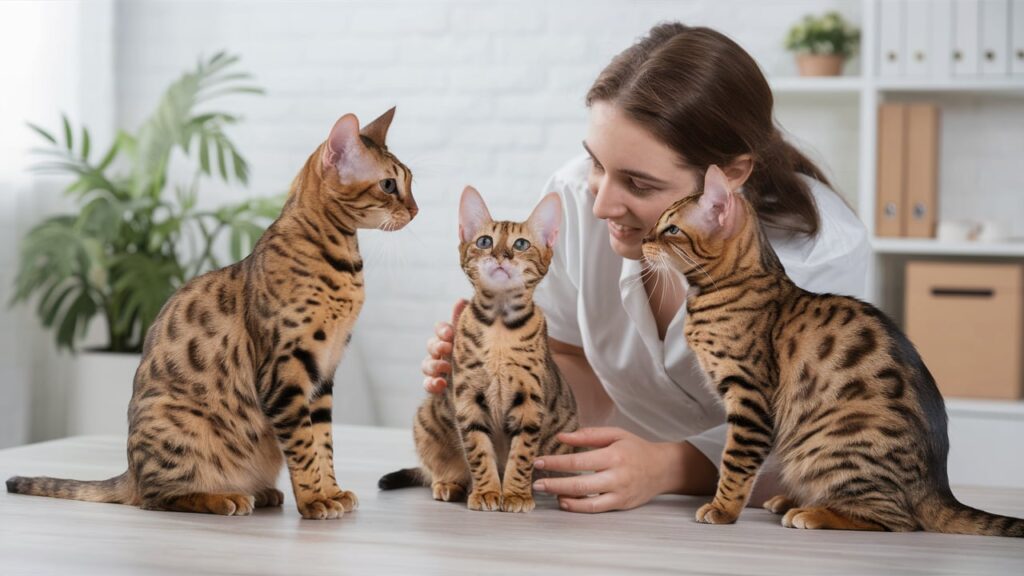
The Importance of Supporting Responsible Breeders
Responsible breeders will ensure that their cats are healthy, well-socialized, and cared for in a loving environment. By choosing a responsible breeder, you’re supporting ethical practices and helping to ensure the future of the breed.
The Future of the Orange Bengal Cat
Trends in Bengal Cat Breeding
The demand for Bengal cats, including the orange variety, continues to grow. As more people discover the beauty and charm of these cats, responsible breeding practices will be essential to maintaining the health and integrity of the breed.
The Growing Popularity of the Orange Bengal
As the orange Bengal cat becomes more well-known, its popularity is likely to increase. However, it’s crucial to remember that owning a Bengal cat, regardless of color, is a long-term commitment that requires time, attention, and care.
Conclusion
In conclusion, the orange Bengal cat is a truly unique and captivating companion. With their stunning looks, lively personality, and relatively low maintenance needs, they make excellent pets for those who can meet their high energy levels and need for interaction. If you’re considering adding an orange Bengal to your family, make sure to do your research, choose a reputable breeder, and be prepared for a lifelong commitment to a truly special cat.
FAQs
How rare is an orange Bengal cat?
Orange Bengal cats are relatively rare compared to other Bengal colors, which makes them highly sought after by cat enthusiasts.
Do orange Bengal cats have different care requirements?
No, orange Bengal cats have the same care requirements as other Bengals, including grooming, diet, and exercise needs.
Are orange Bengal cats more expensive than other Bengal cats?
Yes, due to their rarity, orange Bengal cats can be more expensive than other Bengal varieties.
What is the lifespan of an orange Bengal cat?
Similar to other Bengals, orange Bengal cats can live up to 16 years if given the right care.
How can I find a reputable breeder for an orange Bengal cat?
To find a reputable breeder, research breeders who prioritize health, temperament, and responsible breeding practices. Look for those who can provide health certifications and allow you to meet the kitten’s parents.
